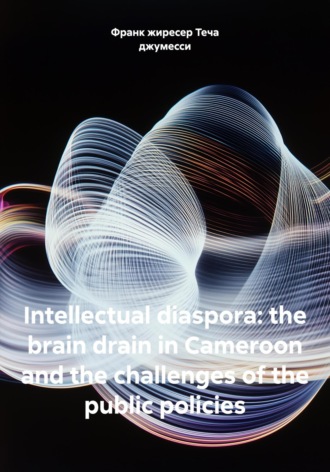
Полная версия
Intellectual diaspora: the brain drain in Cameroon and the challenges of the public policies
3
Stark, O., Helmenstein, C., & Prskawetz, A. (1997). A brain gain with a brain drain. Economics Letters, 55(2), 227-234.
4
Kerr, S. P., Kerr, W. R., & Özden, Ç. (2016). Global talent flows. Journal of Economic Perspectives, 30(4), 165-192.
5
Abramitzky, R., & Lavy, V. (2014). Human capital or cultural capital? Ethnicity and parental schooling effects on children's cognitive skills. Journal of Human Resources, 49(3), 611-640.
6
Bhagwati, J., & Hamada, K. (1974). The brain drain, international integration of markets for professionals and unemployment: A theoretical analysis. Journal of Development Economics, 1(1), 19-42.
7
Commander, S., Chanda, R., & Kangasniemi, M. (2008). Brain drain: Causes, consequences and policy responses. Handbook of the Economics of Innovation, 2, 1435-1493.
8
Ratha, D. (2003). Workers' remittances: An important and stable source of external development finance. Global development finance.
9
Dustmann, C., Fadlon, I., & Weiss, Y. (2011). Return migration, human capital accumulation and the labour market. Journal of Development Economics, 95(1), 58-67.
10
Agrawal, A., Kapur, D., & McHale, J. (2011). How do return and non-return migrants differ? Evidence from the Indian Institutes of Technology. Journal of Development Economics, 96(1), 189-202.
11
OECD. (2002). International mobility of the highly skilled. OECD Publishing.
12
Lowell, B. L., & Findlay, A. (2001). Migration of highly skilled persons from developing countries: Impact and policy responses. International Migration Papers, (44).
13
Dodani, S., & LaPorte, R. E. (2005). Brain drain from developing countries: how can brain drain be converted into brain gain? Journal of the Royal Society of Medicine, 98(12), 569-574.
14
Gamlen, A. (2008). Diaspora institutions and diaspora governance. International Migration Review, 42(3), 579-614.
15
Massey, D. S., Arango, J., Hugo, G., Kouaouci, A., Pellegrino, A., & Taylor, J. E. (1993). Theories of international migration: A review and appraisal. Population and Development Review, 19(3), 431-466.
16
Portes, A., & Rumbaut, R. G. (2001). Legacies: The story of the immigrant second generation. University of California Press.
17
Schiller, N. G., Basch, L., & Blanc-Szanton, C. (1992). Transnationalism: A new analytic framework for understanding migration. In N. G. Schiller, L. Basch, & C. Blanc-Szanton (Eds.), Towards a transnational perspective on migration: Race, class, ethnicity, and nationalism reconsidered (pp. 1-24). New York Academy of Sciences.
18
Acemoglu, D., & Robinson, J. A. (2012). Why nations fail: The origins of power, prosperity, and poverty. Crown Publishers.
19
Transparency International. (2023). Corruption Perceptions Index. Retrieved from https://www.transparency.org/en/cpi/
20
North, D. C. (1990). Institutions, institutional change and economic performance. Cambridge University Press.
21
Agunias, D. R., & Newland, K. (2012). Leveraging economic development through diaspora engagement: A guide for policymakers and practitioners. Migration Policy Institute.
22
World Bank. (2023). Remittance inflows. World Bank Data. Retrieved from https://www.worldbank.org/en/news/press-release/2023/12/18/remittance-flows-grow-2023-slower-pace-migration-development-brief
23
IOM. (2020). Migration in Cameroon: A profile. International Organization for Migration.
24
Docquier, F., & Rapoport, H. (2004). Skilled migration: A survey of the literature. Journal of Economic Surveys, 18(1), 1-58.
25
Saxenian, A. L. (2005). From brain drain to brain circulation: Transnational communities and regional upgrading in India and China. Studies in Comparative International Development, 40(2), 35-61.
26
Transparency International. (2023). Op. Cit.
27
Sindze, F. (2019). The Impact of Brain Drain on the Development of Cameroon. Journal of Education and Social Research, 9(2), 78-87.
28
Fomba Kamga, J. (2017). The Impact of Brain Drain on the Development of Cameroon. Journal of Social Sciences, 51(2), 269-276.
29
Konings, P. (2007). Migration and the politics of belonging in Cameroon. African Diaspora, 1(1), 5-27.
30
Ngwanza, C. (2018). Education in Cameroon: Challenges and Prospects. Journal of Education and Practice, 9(1), 25-33.
31
Amnesty International. (2021). Cameroon: Anglophone crisis. Retrieved from https://www.amnesty.org/en/location/africa/central-and-west-africa/cameroon/report-cameroon/
32
Docquier, F., & Marfouk, A. (2006). Globalization, Brain Drain, and Development. The Journal of Development Studies, 42(2), 125-150.
33
Ayissi, A. (2011). Cameroun : L'enjeu politique. Karthala.
34
International Crisis Group. (2019). Cameroun : Un conflit anglophone au bord du précipice.
35
Transparency international. Op. Cit.
36
Assoumou, J. (2015). Education et développement au Cameroun : Enjeux et perspectives. Yaoundé: Presses Universitaires d'Afrique.
37
Onguene, R. (2018). Jeunesse et emploi au Cameroun : Défis et opportunités. Douala: Editions Africavenir.
38
Fonjong, L., & Akwa, C. (2016). Emigration dynamics, livelihoods and development in rural Cameroon. Journal of Anthropological Research, 72(3), 359-381.
39
Mbembe, A. (2001). On the postcolony. University of California Press.



